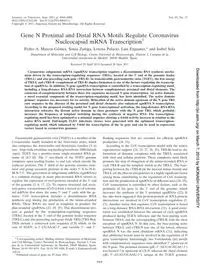
2011 Gene N Proximal and Distal RNA Motifs Regulate Coronavirus Nucleocapsid mRNA Transcription PDF
Preview 2011 Gene N Proximal and Distal RNA Motifs Regulate Coronavirus Nucleocapsid mRNA Transcription
JOURNAL OF VIROLOGY, Sept. 2011, p. 8968–8980 Vol. 85, No. 17 0022-538X/11/$12.00 doi:10.1128/JVI.00869-11 Copyright © 2011, American Society for Microbiology. All Rights Reserved. Gene N Proximal and Distal RNA Motifs Regulate Coronavirus Nucleocapsid mRNA Transcription� Pedro A. Mateos-Go´mez, Sonia Zun˜iga, Lorena Palacio, Luis Enjuanes,* and Isabel Sola Department of Molecular and Cell Biology, Centro Nacional de Biotecnología, Darwin 3, Campus de la Universidad Autonoma de Madrid, 28049 Madrid, Spain Received 29 April 2011/Accepted 20 June 2011 Coronavirus subgenomic mRNA (sgmRNA) transcription requires a discontinuous RNA synthesis mecha- nism driven by the transcription-regulating sequences (TRSs), located at the 3� end of the genomic leader (TRS-L) and also preceding each gene (TRS-B). In transmissible gastroenteritis virus (TGEV), the free energy of TRS-L and cTRS-B (complement of TRS-B) duplex formation is one of the factors regulating the transcrip- tion of sgmRNAs. In addition, N gene sgmRNA transcription is controlled by a transcription-regulating motif, including a long-distance RNA-RNA interaction between complementary proximal and distal elements. The extension of complementarity between these two sequences increased N gene transcription. An active domain, a novel essential component of the transcription-regulating motif, has been identified. The active domain primary sequence was necessary for its activity. Relocation of the active domain upstream of the N gene TRS core sequence in the absence of the proximal and distal elements also enhanced sgmRNA N transcription. According to the proposed working model for N gene transcriptional activation, the long-distance RNA-RNA interaction relocates the distant active domain in close proximity with the N gene TRS, which probably increases the frequency of template switching during the synthesis of negative RNA. The transcription- regulating motif has been optimized to a minimal sequence showing a 4-fold activity increase in relation to the native RNA motif. Full-length TGEV infectious viruses were generated with the optimized transcription- regulating motif, which enhanced by 5-fold the transcription of the 3a gene and can be used in expression vectors based in coronavirus genomes. Transmissible gastroenteritis virus (TGEV) is a member of the Coronaviridae family included in the Nidovirales order, which also comprises the Arteriviridae and Roniviridae families (3, 6) (see http://talk.ictvonline.org/media/g/vertebrate-2008/default .aspx). TGEV has a positive-sense single-stranded RNA ge- nome of 28.5 kb. The 5� two-thirds of the TGEV genome comprises open reading frames 1a and 1ab, which encode the replicase proteins. The 3� third of the genome encodes struc- tural and group accessory proteins in the order 5�-S-3a-3b-E- M-N-7-3�. The generation of subgenomic mRNAs (sgmRNAs) is a common strategy in many plus-stranded RNA viruses to regulate the expression of viral proteins encoded at the 3� end of the genome (5, 6, 17, 22). To express structural and acces- sory genes, coronaviruses (CoVs) form a nested set of cotermi- nal mRNAs that share the same 5� and 3� ends with the ge- nome. CoV transcription includes a discontinuous RNA synthesis step during the production of the minus-stranded RNAs. These RNAs are used as templates to produce the plus-stranded sgmRNAs (22, 28, 35). This discontinuous pro- cess is guided by the transcription-regulating sequences (TRSs), located at the 3� end of the genomic leader sequence (TRS-L) and also preceding each gene (body TRSs [TRS-Bs]). TRSs include a conserved core sequence (CS) which, in the case of TGEV, is 5�-CUAAAC-3�, and variable 5�- and 3�- flanking sequences that are essential for efficient sgmRNA production (28, 35). According to the CoV transcription model with the widest experimental support (24, 25, 27, 28, 35), TRS-Bs lead to the formation of dynamic complexes with the TRS-L associated with viral and cellular proteins. These complexes most likely promote the stop of elongation of the minus-stranded RNA at each TRS-B and the template switch to the TRS-L. The base- pairing between the cTRS-B (in the nascent minus strand) and TRS-L (in the plus-strand genome) is a highly significant factor among those contributing to the regulation of CoV transcrip- tion and the production of sgmRNAs of different sizes (28, 35). CoV transcription is controlled by other factors, such as the proximity of the gene to the 3� end of the genome, which increases the synthesis of the 3�-proximal sgmRNAs (22). It has also been suggested that protein-protein or RNA-protein interactions are involved in CoV transcription regulation (5, 27). Another factor that regulates CoV transcription is based on a long-distance RNA-RNA interaction (21). A good corre- lation was established between the amount of each sgmRNA produced during TGEV infection and the base-pairing score between TRS-L and the corresponding cTRS-B, with the clear exception of sgmRNA N. In this case, the base-pairing score between TRS-L and cTRS-N was one of the lowest, whereas sgmRNA N was the most abundant mRNA (21), indicating that additional factors must be involved in the regulation of N gene transcription. Interestingly, two 9-nucleotide (nt) motifs with complementary sequences were identified 5� upstream of the N gene. The proximal element (pE; 5�-AUUACAUAU-3�) was located 7 nt upstream of CS-N, whereas the distal element (dE; 5�-AUAUGUAAU-3�), unique in the TGEV genome, * Corresponding author. Mailing address: Department of Molecular and Cell Biology, Centro Nacional de Biotecnología, Darwin 3, Cam- pus de la Universidad Autonoma de Madrid, 28049 Madrid, Spain. Phone: 34-91-585 4555. Fax: 34-91-585 4506. E-mail:
